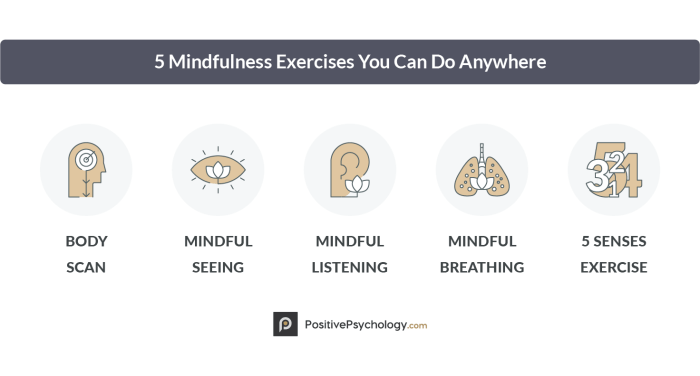Mindfulness Exercises are a powerful tool for improving mental health and overall well-being. By incorporating these practices into your daily routine, you can experience reduced stress, increased focus, and a greater sense of inner peace. Let’s dive into the world of mindfulness exercises and discover how they can positively impact your life.
Introduction to Mindfulness Exercises

Mindfulness exercises are practices that focus on bringing attention to the present moment without judgment. These exercises help individuals become more aware of their thoughts, feelings, and sensations, ultimately promoting a sense of calm and clarity.
Practicing mindfulness exercises regularly can lead to a variety of benefits, including reduced stress and anxiety, improved focus and concentration, enhanced emotional regulation, and increased overall well-being.
Popular Mindfulness Exercises
- Body Scan: A practice that involves focusing on different parts of the body, bringing awareness to any sensations or tension present.
- Deep Breathing: A simple exercise that involves taking slow, deep breaths to calm the mind and body.
- Mindful Walking: Walking slowly and deliberately, paying attention to each step and the sensations of movement.
- Loving-Kindness Meditation: A practice that involves sending well wishes and compassion to oneself and others.
Types of Mindfulness Exercises

When it comes to mindfulness exercises, there are various techniques that can help you stay present and focused. Let’s explore some of the most common types and how to effectively practice them.
Meditation
Meditation is a popular mindfulness exercise that involves focusing your mind and eliminating distractions. Find a quiet space, sit or lie down comfortably, close your eyes, and focus on your breath. When your mind starts to wander, gently bring your focus back to your breath. Start with short sessions and gradually increase the time as you build your practice.
Deep Breathing
Deep breathing exercises help calm the mind and reduce stress. Sit or lie down in a comfortable position, place one hand on your chest and the other on your stomach. Inhale deeply through your nose, allowing your stomach to rise, then exhale slowly through your mouth. Repeat this process for a few minutes, focusing on the sensation of your breath entering and leaving your body.
Body Scan
A body scan involves bringing awareness to different parts of your body, one by one, to release tension and promote relaxation. Lie down in a comfortable position, close your eyes, and start by focusing on your toes. Slowly move your attention up through each body part, noticing any sensations or feelings without judgment. This exercise can help you connect with your body and relieve physical tension.
Incorporating Mindfulness Exercises into Daily Routine
Integrating mindfulness exercises into your daily routine can have numerous benefits for your mental and physical well-being. By taking the time to be present and mindful, you can reduce stress, improve focus, and enhance overall quality of life.
Importance of Integrating Mindfulness Exercises
- Reduce stress and anxiety levels
- Improve focus and concentration
- Promote emotional well-being
Tips to Make Mindfulness Exercises a Habit
- Start small: Begin with just a few minutes of mindfulness practice each day and gradually increase the duration.
- Set reminders: Use alarms or notifications on your phone to prompt you to engage in mindfulness exercises.
- Find a routine: Incorporate mindfulness exercises into your daily schedule, such as right after waking up or before bedtime.
Examples of Mindfulness Exercises in Different Settings
Whether you’re at home, work, or in a public place, there are various ways to practice mindfulness:
- At home: Try deep breathing exercises, guided meditation, or body scan techniques in the comfort of your own space.
- At work: Take mindful breaks by focusing on your breathing, practicing gratitude, or doing a quick walking meditation during lunchtime.
- In public places: Practice mindful listening by paying attention to sounds around you, engage in sensory awareness exercises, or simply take a moment to observe your surroundings without judgment.
Mindfulness Exercises for Stress Relief
When it comes to reducing stress and anxiety, mindfulness exercises can be incredibly effective. By focusing on the present moment and increasing self-awareness, these exercises can help individuals manage their emotions and reactions better.
Specific Mindfulness Exercises for Stress Relief
- Deep Breathing: Taking slow, deep breaths can help calm the mind and body, reducing stress levels.
- Body Scan Meditation: This practice involves focusing on different parts of the body, releasing tension and promoting relaxation.
- Mindful Walking: Paying attention to each step and the sensations of walking can help clear the mind and reduce stress.
- Loving-Kindness Meditation: Cultivating feelings of love and compassion towards oneself and others can reduce stress and increase positivity.
Real-life Scenarios of Mindfulness for Stress Relief
Imagine a student feeling overwhelmed with schoolwork and exams. By practicing mindfulness exercises such as deep breathing or body scan meditation, they can calm their nerves and focus on the task at hand, reducing stress levels and improving concentration.
Another example could be a working professional dealing with a high-pressure job. Mindful walking during breaks or practicing loving-kindness meditation before a stressful meeting can help them stay grounded, manage stress effectively, and maintain a positive mindset throughout the day.